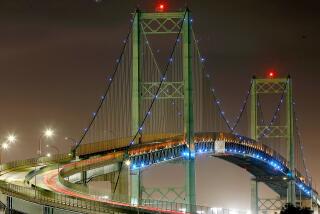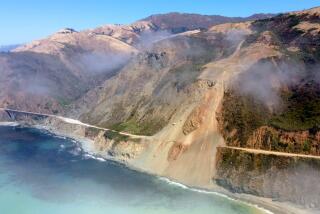‘Hype’ Over Nimitz Fall Jolts Panel : Public works: Transit commissioners fear that the media emphasis on quake damage to bridges may short-change other vital programs.
- Share via
SACRAMENTO — California Transportation Commission members expressed fears Wednesday that the “media hype” surrounding the collapse of Oakland’s Nimitz Freeway may create so much political pressure for bridge safety that other programs will be sacrificed.
Commission members told Transportation Department Director Robert Best they were concerned that the attention devoted to seismic safety as a result of last month’s earthquake may force lawmakers to devote a disproportionate share of the state’s tax resources to a bridge retrofitting program.
“I think what worries us is that too much media hype might skew our monies to the hundreds of millions to billions of dollars (for) refixing what’s already built without trying to look at the safety factors of the major projects that we have still in the development stage,” said commission member Joseph Levy of Fresno.
On a “good weekend” the number of highway deaths in California, he said, will equal or surpass the 41 fatalities attributed to the collapse of the 1 1/4-mile section of the Nimitz. And on California 99 between Bakersfield and Sacramento, he said, an average of two people are killed every day.
“In a month’s time (on California 99) we equal what was killed in the earthquake, and that’s every month, month in and month out,” Levy said.
Best said although the Legislature had determined during a special session that bridge retrofitting was a “priority program” and earmarked $80 million from a quarter-cent sales tax increase for it, lawmakers had not indicated that other programs should be postponed to continue financing it.
He said money to pay for the program, estimated to cost a minimum of $300 million, would not come from Caltrans’ regular highway construction program but from federal emergency funds and the special state tax. The quarter-cent increase in the state’s 6% sales tax will go into effect for 13 months beginning Dec. 1.
“I’m sure it was not the intent of the Legislature . . . to suggest that the commission should abandon other safety programs as part of this,” Best said.
However, he warned that all road projects, including the retrofitting program, will face serious funding problems if voters do not endorse a 9-cents-per-gallon increase in the state’s gasoline tax next June. The tax increase is designed to finance an $18.5-billion, 10-year transportation improvement program.
Caltrans had just completed the first phase of its seismic retrofitting program and had not yet embarked on the second phase when the earthquake struck Oct. 17. Phase 1, begun after the 1971 San Fernando earthquake, involved securing bridge decks to prevent slippage during a temblor. The second phase required that single columns on bridges built before 1971 be fitted with steel jackets to contain them during ground shaking.
Caltrans engineers had not scheduled multicolumn bridges for retrofitting until a third phase of the program because they believed that those bridges were not as vulnerable to damage in an earthquake as the single column structures. Best said the collapse of the Nimitz, a multicolumn bridge, prompted officials to change their minds and reset priorities so that Phase 2 and 3 would be completed almost simultaneously.
Saying he did not want the “wrong message to come out of this commission,” Chairman Joseph Duffel said commission members did not mean to imply that earthquake safety would not continue to be a top priority. Rather, he said, they were expressing their desire that other programs not be sacrificed to pay for it.
More to Read
Sign up for Essential California
The most important California stories and recommendations in your inbox every morning.
You may occasionally receive promotional content from the Los Angeles Times.










